Welcome to our van! It is a 177″ wheel base extended high-top Mercedes Sprinter cargo van, coming in at 24 feet in length and just over nine feet in height.
There are generally three van models that are used for conversion or adventure vans. Both the Dodge ProMaster and Ford Transit vans are wider than the Sprinter, but they are also shorter in height inside. For Doug to be able to stand up in the van, we had no choice but to go with the Sprinter.
Once we made our decision to move forward with van life, we began to watch sale listings for vans that had already been converted, but these were practically non-existent on the East Coast. And thanks to the pandemic-induced car-buying frenzy, it was not even possible to go to a Mercedes truck/van dealership and simply buy a Sprinter off the lot. As a result, we special-ordered a plain cargo van in October 2021–and then we waited.
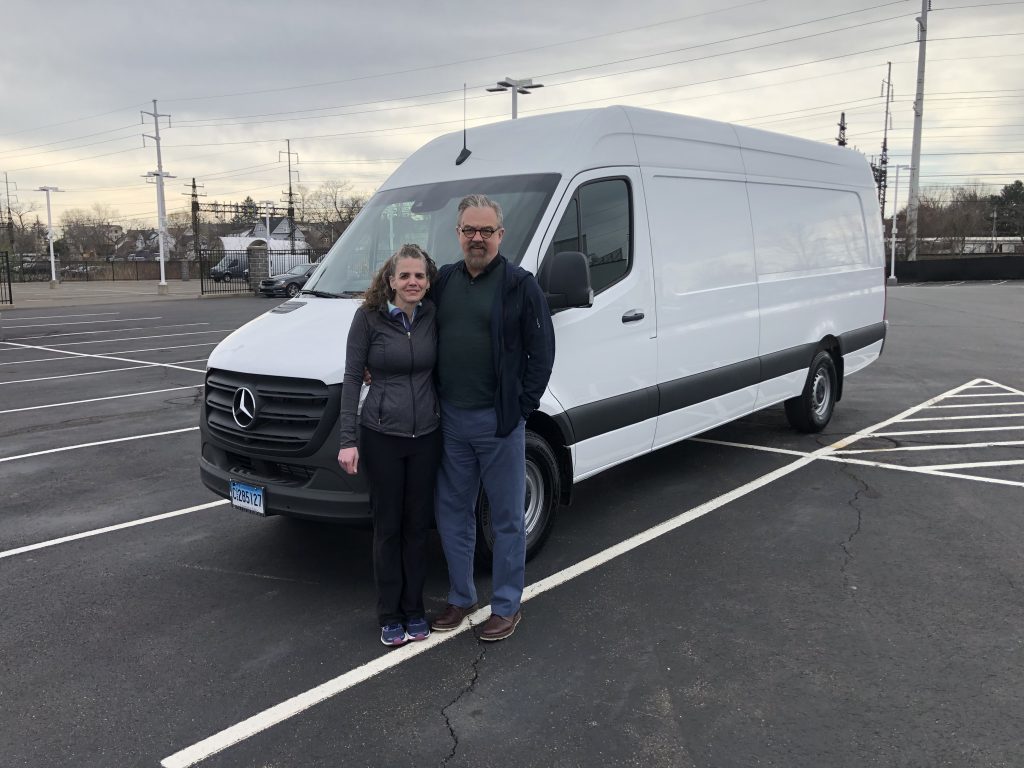
We finally took delivery of the van in early April 2022. The upside of ordering the van instead of buying it out of dealer inventory meant that we were able to specify exactly which features we wanted, and even so, supply chain challenges meant that some features could not be included in the final build.
Once we finally took possession of the van, we began in earnest to find a van upfitter to build out the interior. This was a several month-long process of interviewing builders while we finalized our thoughts about the interior layout. We talked ad nauseam about the layout and finally reached a point where we felt confident our design. Of course, at the last minute we took a hard turn and threw out all three of our top design ideas and went with something completely different.
Did we actually buy and design a van and go all in without ever having rented a van for a night or even having looked in someone else’s converted van? Yes, yes we did. But we did review dozens of van conversions courtesy of Facebook and Instagram and YouTube, which helped us enormously in nailing down our priorities and desires.
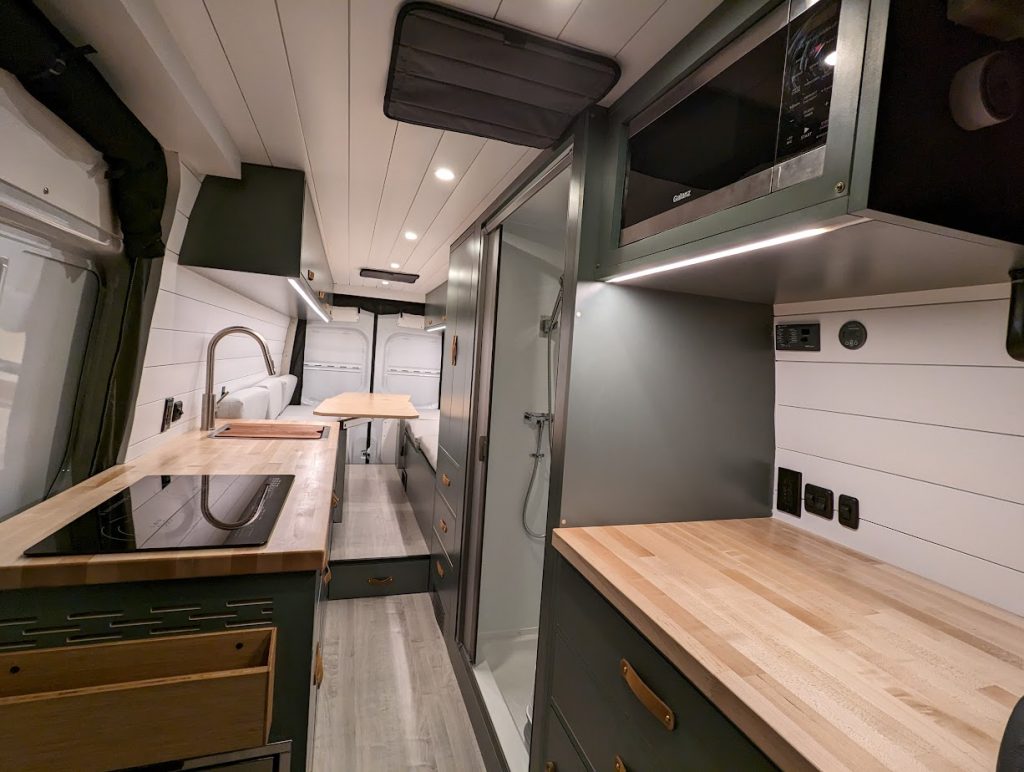
We hired Sequoia + Salt in Wall, N.J., to build our van, which was conveniently not too far from my parents’ home. We had seen their work at an RV show in early 2022, and the owner Chris spent many hours on the phone with us answering our questions and pushing back on some of our crazier ideas.
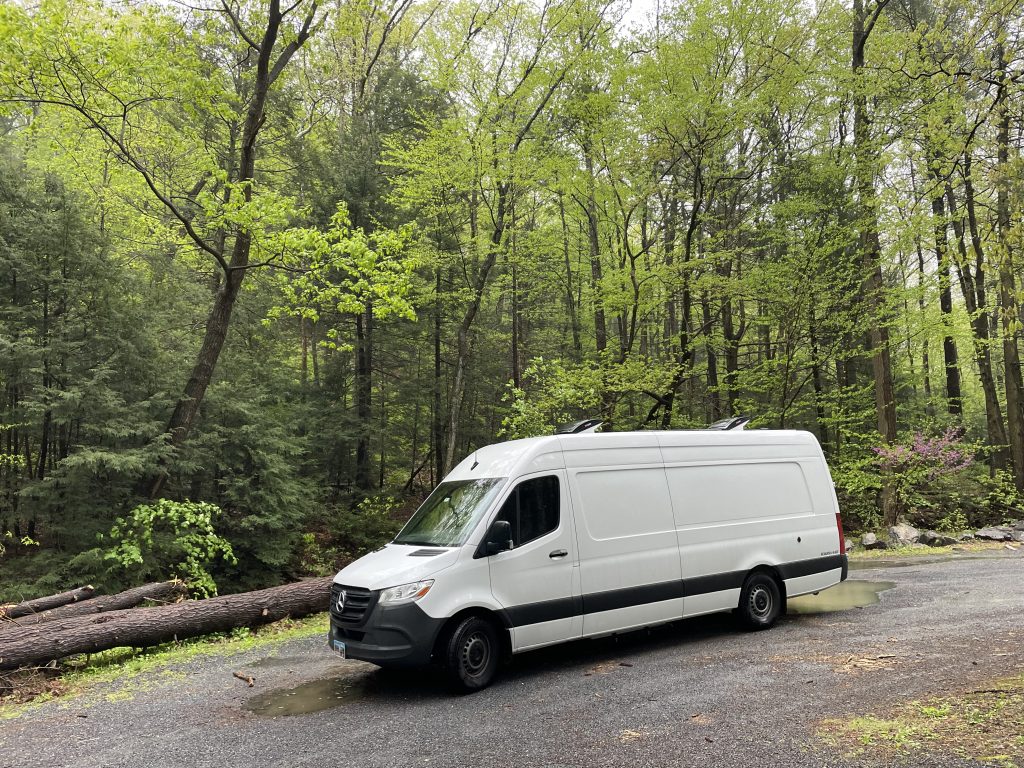
On the outside, we have opted to keep the van looking as business-like as possible. We would prefer not to broadcast that people are actually living or camping in the van. For that reason, there are no ladders and no exterior storage boxes.
On the roof we have solar panels, some gear for internet and cell phone connectivity, and two air vent fans.
Our solar system generates enough power to serve our needs without having to continuously plug into shore power. The air vent fans allow for plenty of ventilation, and both can be set to exhaust air or bring in fresh air, so when used together can creating a significant amount of airflow.
Inside, we were very lucky to get two swivel seats (thanks to the pandemic parts shortage, we were one of the last vans coming out of the factory to get them). We have full black-out window shades, which can also really help keep the heat out, along with a blackout curtain between the cab and the back. Above the cab we have overhead storage where we keep our traction tracks in case we get stuck in the mud or snow (can’t wait for that, it’s inevitable!), along with some other less-used gear.
Behind the driver’s seat is a cabinet that has Mr. K’s litter (accessible through a custom door with a portal in it) and other supplies, plus two drawers. There’s a small counter here, with a microwave/convection oven/air fryer combo that is small but oh-so-useful. We’ve baked cookies in it along with more mundane cooking and reheating tasks.
Beside this counter is our bathroom with a shower. Yes, it is a real shower, but we have limited water carrying capacity, so we do not use it for taking real showers but those in the navy or military style: “get wet, turn off water, wash up, turn on water and quickly rinse off.” We do have hot water that can be generated on demand but takes about ten minutes to initially heat up.
So far we’ve used our Planet Fitness memberships to take regular showers, but that good fortune is not going to hold out forever as we move into remoter areas.
We also have a shower hookup at the back of the van, so if we were camped in a remote spot or at the beach we could clean off without getting into the van.
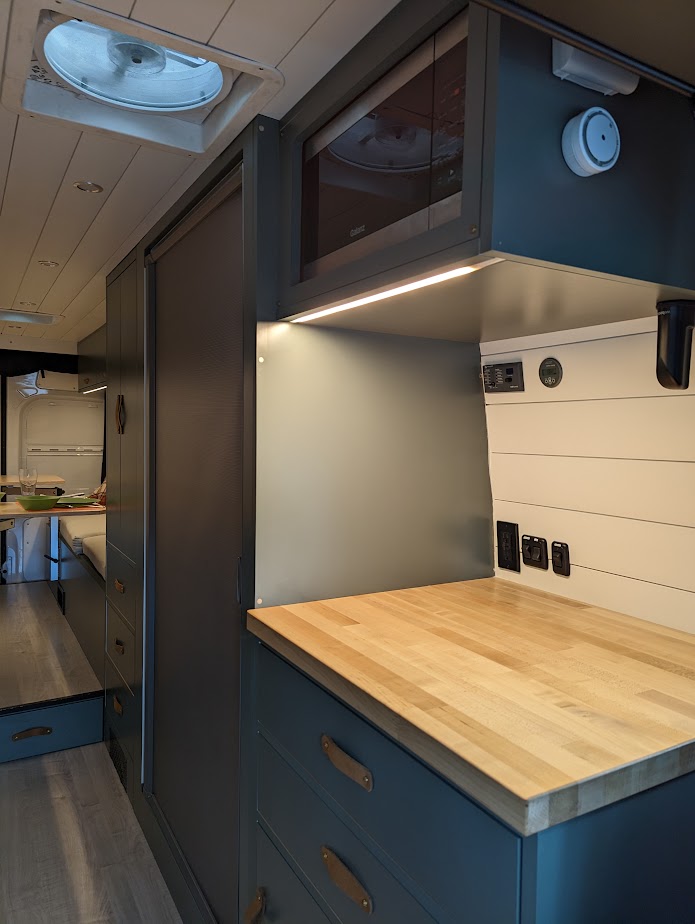
We have a cassette toilet in the shower; this is a self-contained unit that can be picked up and moved, with no attachments or plumbing. This allows us to not have a “black water” waste tank which requires special handling in order to dump the contents. The downside is that when the cassette toilet’s waste tank is full it needs to be disconnected from the toilet and then dumped into any restroom toilet. We mitigate the need to do this frequently by using public restrooms at every opportunity, and also by using a special hospital-style bottle to capture the times when we need to “make water” (to use a euphemism from days gone by). We see this as a small price to pay for having a grand adventure!
Beyond the shower/toilet we have a tall closet with more drawers beneath, which is used mostly for food, laundry, and gear. Across from the bathroom and closet is the cargo van sliding door and a kitchen counter. Beneath the counter is a small fridge (the size of a dorm room fridge), more drawers with kitchen items, and a sink with hot and cold water and a nozzle and sprayer. The water is driven by a 12-volt pump with a switch on the wall behind the sink. We also have an induction cooktop with two burners, which works quite efficiently. Over the sink area are cabinets with more storage.
The back half of the van is seating/bed/storage. Long benches run down each side with three storage compartments on each side. The benches on one side have a false bottom with the complete electrical system, batteries, and solar charge controllers running underneath, but the top two-thirds of each compartment is all easily-accessed storage. On the other side of the van, the middle compartment contains most of the water tank, the water pump, and the heater which is used both for hot water as well as to heat the van while it is parked.
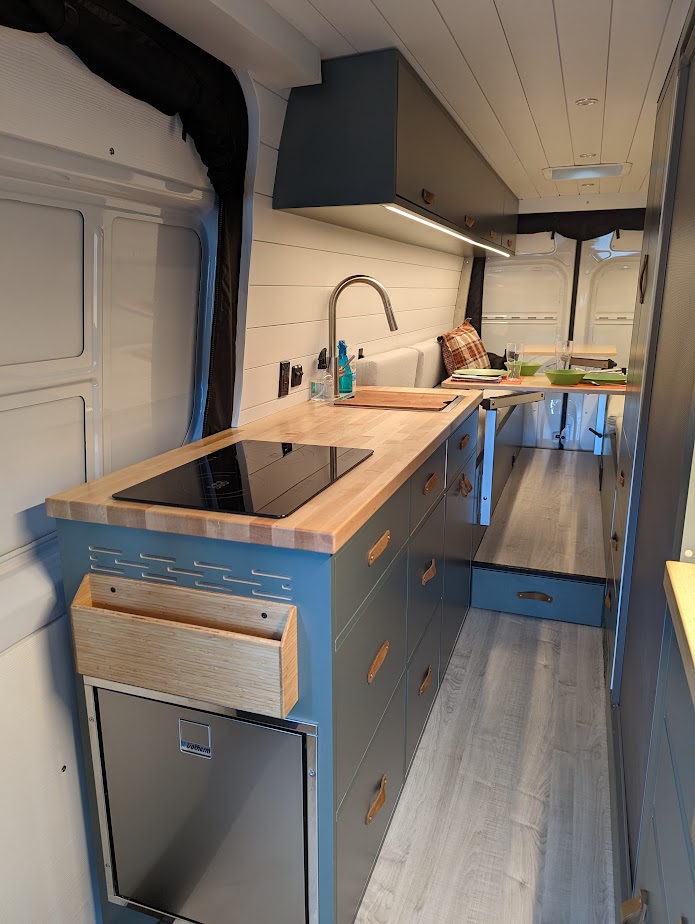
Above the benches are the overhead storage compartments that run the length of the van. Down the middle of the floor is yet more storage, with a small drawer that pulls into the van, and a very long drawer that pulls out the back. The rear drawer is especially useful for van equipment such as extension cords, water hoses, our electrical adapter plug, and drainage hoses.
Dimmable LED lighting strips run underneath the overhead storage compartments, and LED lights are recessed in the ceiling. There are also a number of 110-volt outlets throughout the van to plug in chargers and laptops and other appliances. We have wireless internet in the van, as well, but I will let Doug talk about that in another post sometime along with more details about our solar and overall power setup.
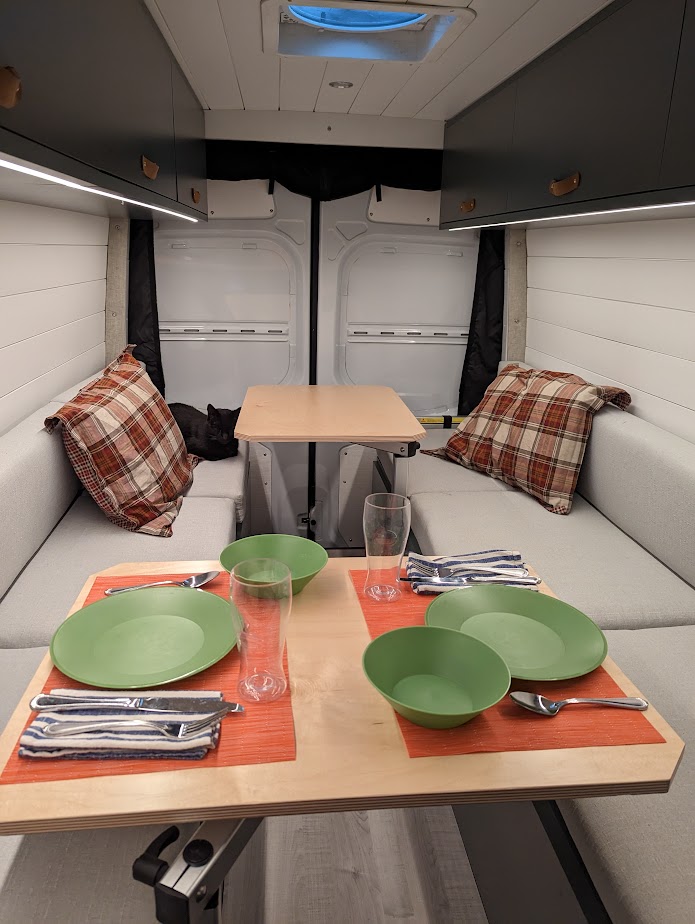
In the back of the van are two adjustable height Lagun-brand tables. These can be swiveled in any direction. At night, the tops of these two tables fit between the benches along with a third board, turning the entire back area into a very large bed (bigger than a queen-sized mattress!).
The Sprinter is just a few inches too narrow to allow for a side-to-side bed, and this is why ours runs from back to front.
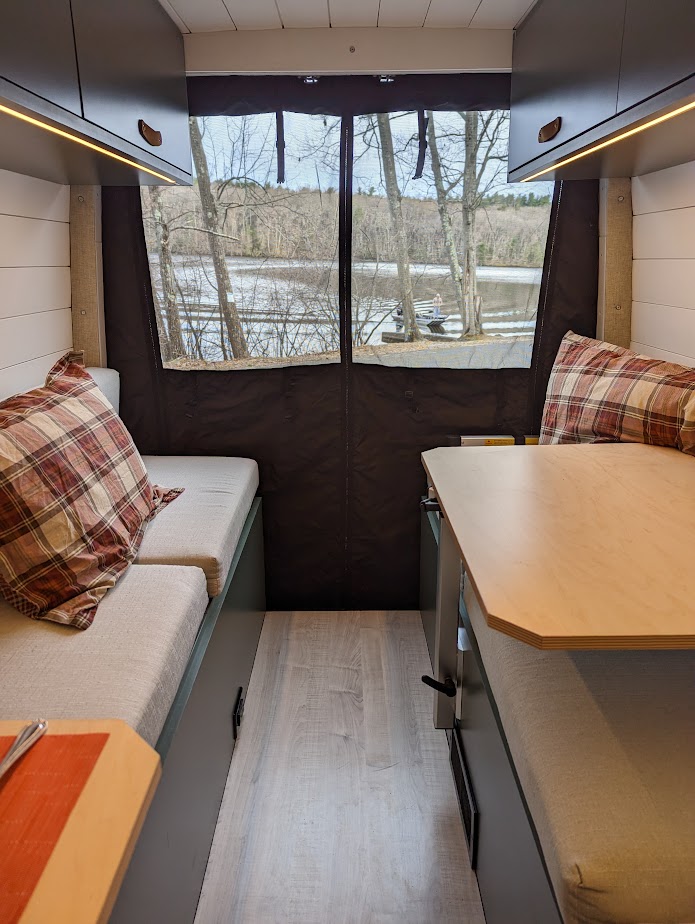
Often van conversions that include a “sideways” bed will put it on top of a storage area called “the garage” that can be accessed from the rear doors. We worked hard to figure out a layout that might allow us to not have to convert the bed to a table every day and at the same time keep Doug from banging his head on the wall while he slept, but it just was not possible. Making and unmaking the bed is bit of a project, taking about 20 minutes each time, and we have settled into just unmaking the first third of the bed and setting up one of the tables for work and meals which seems like a reasonable compromise. Doug likes to then prop up pillows at the back and treat the bed as a large comfy couch.
We could sleep on the two side benches without making up the full bed, but the way we see it, if a portable toilet and complicated bed do require some special attention, these are tiny issues that are enabling us to make this great adventure happen.
We do have heat in the van, which works fabulously. It is tied to the van’s diesel fuel tank, so we never need to worry about filling a separate tank, carrying propane, draining our house batteries, or running the van’s engine in order to stay warm. The diesel heater’s combustion happens outside the van, but we do have a carbon monoxide and a smoke detector inside.
We have stayed in the van with temperatures outside dropping to about 40 degrees F and were very toasty, and I have no concerns about sleeping when it gets even colder. The van’s walls and roof (and floor to a small extent) are all insulated, both for heat and for noise.
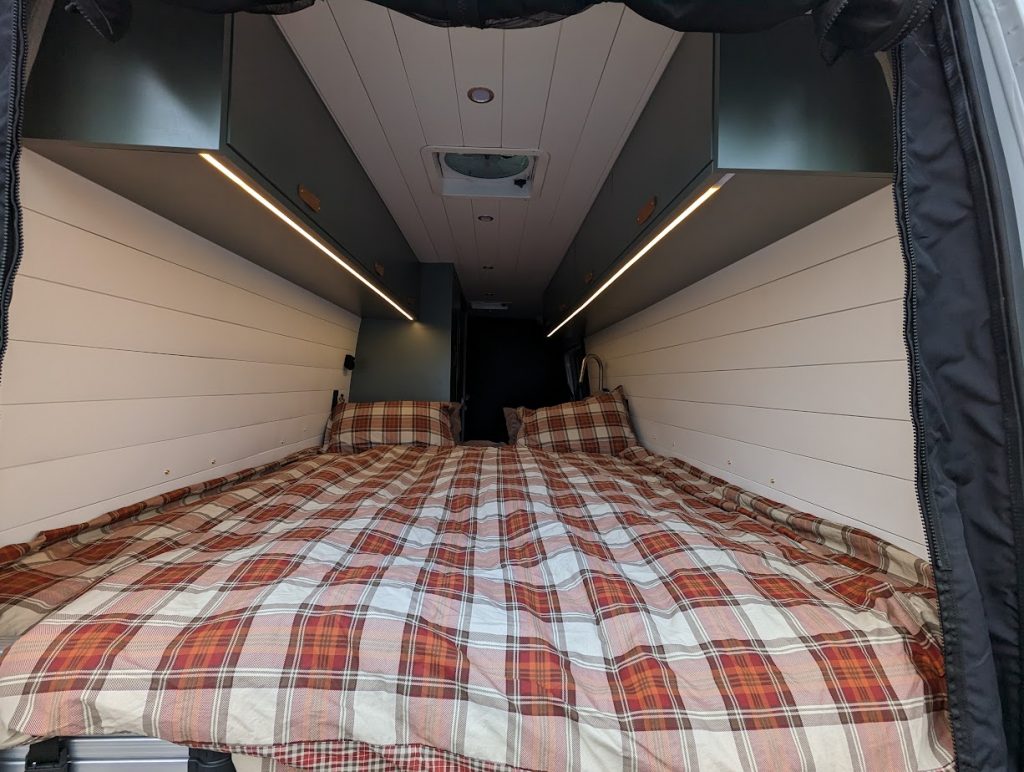
We do not have air conditioning. RV a/c units tend to be very pricey and consume a lot of energy that would drain our solar batteries pretty quickly. We have already experienced outside temperature hit 90 and been quite comfortable in the van with both vent fans running. The blackout curtain behind the cab and the window shades on all the front windows combine to prevent the rest of the van from heating up like the inside of a parked car would do, so we can at least keep the internal temperature equalized with the exterior temperature on a hot day. The paradox is that we often need to park the van in the sun in the daytime so that the solar panels can recharge our battery, but on a very hot day that sun beating down on the rest of the van is not optimal. We also have bug nets that allow us to open the cargo sliding side door and the back doors to capture a breeze, but of course, that is only possible when we are not trying to be stealthy.
Then again, we do not plan to be in Phoenix or Miami in August or Burlington or Minneapolis in February! We expect to travel with the weather as much as we can, seeking out locations with more moderate temperatures throughout the year.
Tiny space living does mean that everything must have a place. You certainly cannot drive with anything loose in the van. Whenever we are dressing or cooking, care has to be taken to retrieve and return all items to their proper homes. Our cooking pots and pans are nested, so to use one we must take out most or all of the pans, set aside the one we want to use, and then put the whole batch back in the drawer, since there is no counter space to leave them if we are trying to make a meal.
Since there is barely enough room for the two of us to pass by each other in the main corridor, we have to coordinate our movements, giving us lots of together time. However, we do not spend every hour of every day in the van! Doug will sometimes work in a coffee shop or restaurant, or we will eat our meals at a picnic table in a park. Since we have limited storage space, we must go grocery shopping more frequently (no Costco in our routines!). We visit the gym daily for workouts and showers, and clean laundry requires a trip to the laundromat. And, obviously, we are traveling to see the country and I do not mean from behind the window of our van. We frequently stop to take Mr. K for a walk, go for a short hike to see some wonder of nature, or take a quick pit stop at some roadside oddity (hello giant coffee pot). So far it has not felt at all claustrophobic to be living in a van.
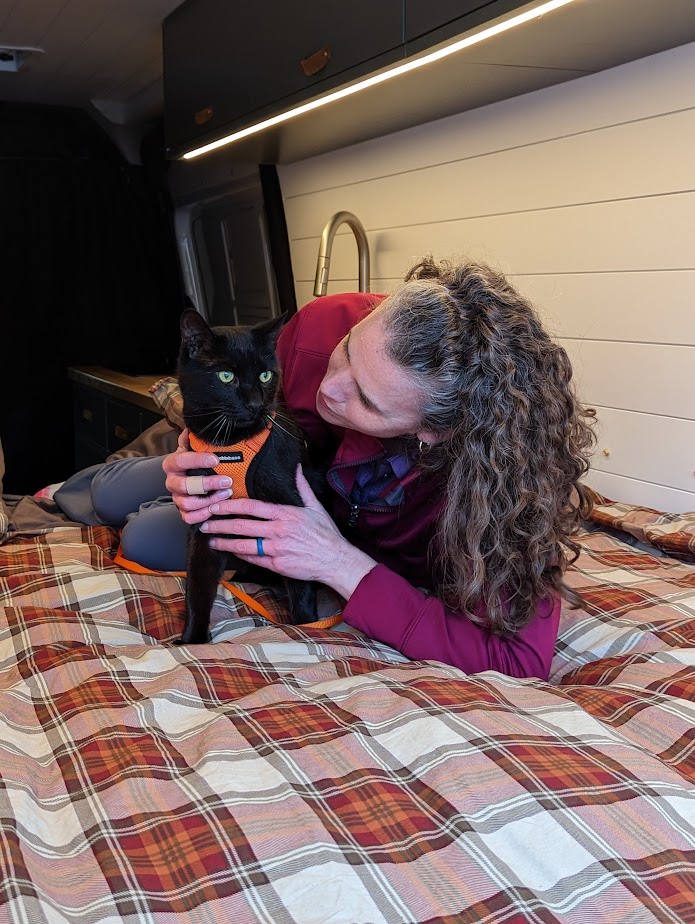
Admittedly, we are still new to this and I am sure we will continue adapting and making changes.
We have a separate post on how we are addressing Mr. K’s needs in the van.
Finally, we have not yet named the van…drop your suggestions!
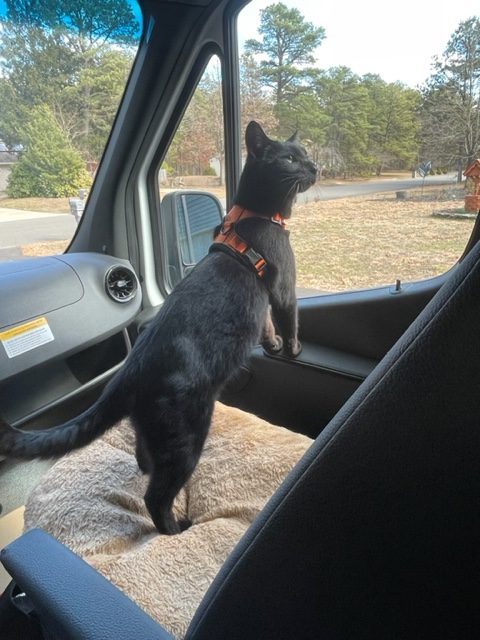
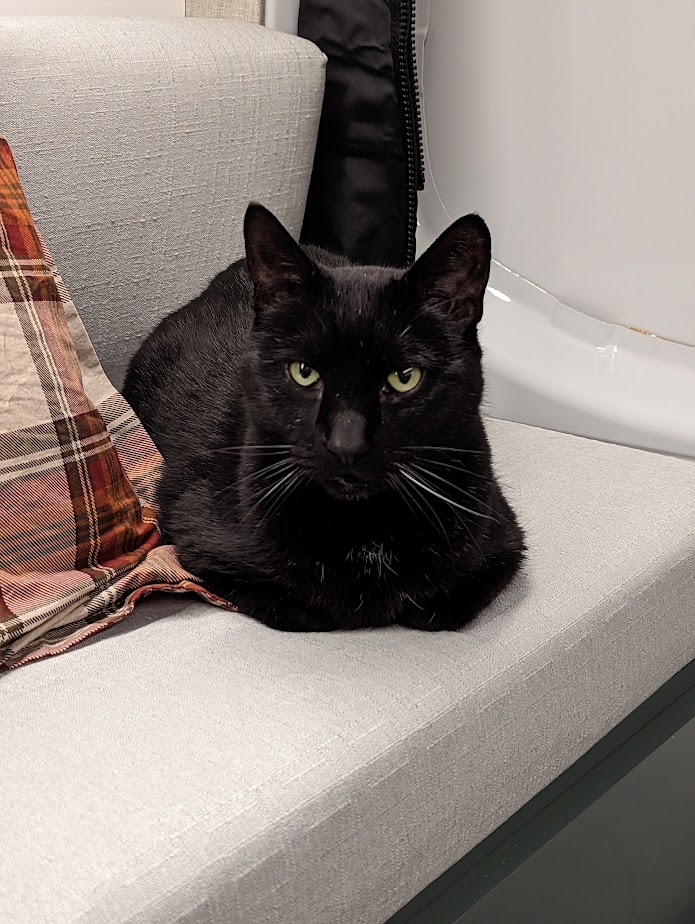
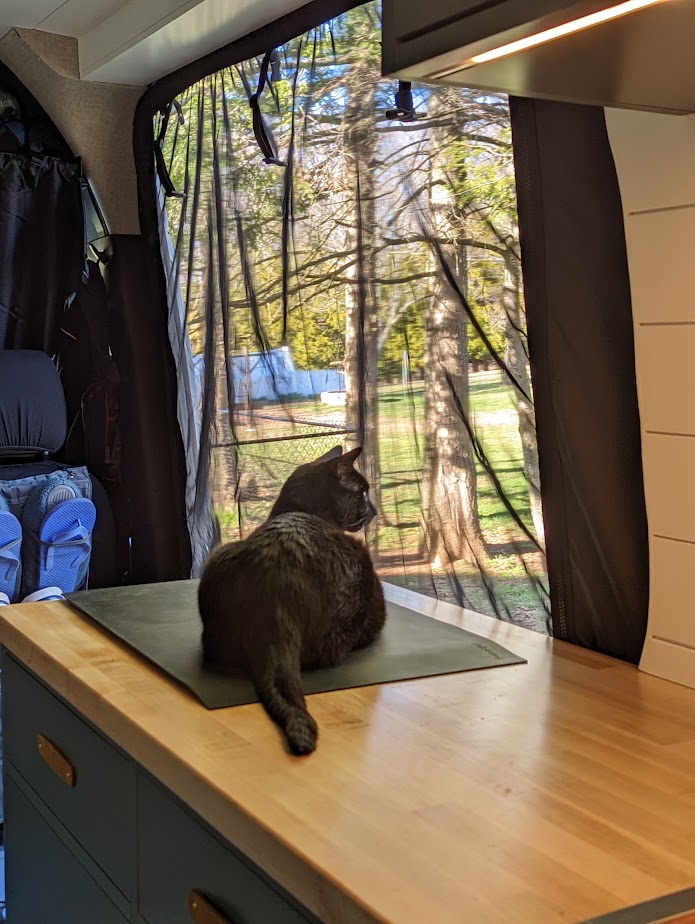





As always, I enjoyed reading and seeing pictures of your new adventure van! I am so extremely excited for you, Doug & Mr K! ❣️
Thanks so much!!!
Sounds Great. Enjoy every minute together. For a name, what do you think of “ourCLUBhouse”. 🙂
We’ll take that under consideration!
Looks like a great design. Have fun on your adventures.